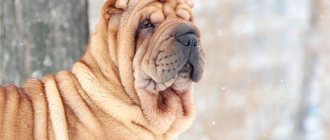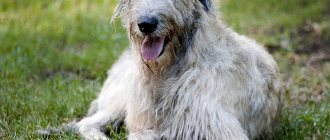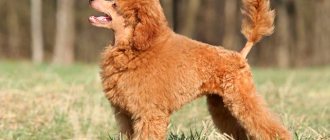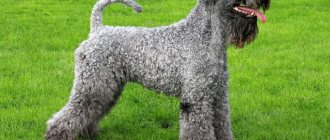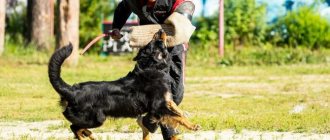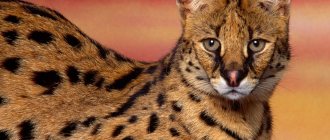History of the St. Petersburg Orchid breed
The idea of creating the breed belonged to Nina Nasibova, the owner of the S Lake Dolgoe nursery, which specialized in breeding Russian toys.
In the 90s, the breeder wanted to give the world a new variety of decorative dogs that combine external charm, but do not require complex grooming and specific care. As a result, the experiment was carried out with the participation of representatives of various toy breeds, which produced heterogeneous offspring in terms of further breeding. Work on the formation of the “orchid” phenotype continued for several years. Moreover, according to Nina Nasibova herself, most of the puppies born were given away for free, as they did not meet her expectations. It was possible to obtain the first individuals similar to today’s “Petersburgers” only in 1997. At the same time, information about the breeding sires used for mating was carefully hidden. According to one version, the owner of the nursery planned in this way to protect the breed from uncontrolled breeding by unscrupulous breeders. On the other hand, for commercial reasons and the desire to retain exclusive copyright.
One way or another, already in 2007 a patent was issued in the name of Nina Nasibova, and her charges received their registration number from the Ministry of Agriculture. So far, the St. Petersburg Orchid breed is in developing status, while at the same time, most of its representatives receive full pedigrees when sold. There is one more interesting nuance that limits the breeding of cute shaggy dogs: at the request of the breeder, mainly pet and show puppies are sold outside the Leningrad region, as well as abroad.
Story
This breed is quite young; it was bred in St. Petersburg only in 1997. Breeder N. Nasibova took a number of individuals of miniature breeds, such as:
- chihuahua;
- Russian colored lapdog;
- Yorkshire Terrier;
- toy poodle.
The work was painstaking, it was not immediately possible to achieve the desired result, but after 3 years Nina managed to get miniature dogs with an interesting appearance and excellent qualities.
The woman herself timed the discovery of the breed to coincide with the city’s tercentenary. Good-natured, attractive, loyal dogs acted as an original gift for the anniversary of this city. This is what explains the name of the breed.
Breed standard St. Petersburg Orchid
Representatives of the breed are compact, elongated dogs that are distinguished by exemplary behavior at home, but love to be active during a walk, if one happens. There are standard (2-4 kg) and low-weight “orchids”, whose body weight ranges from 700 g to 2 kg. Little dogs look incredibly cute and are very popular, but due to anatomical features that complicate reproductive processes, they are never sold as breeding pets.
The height of an adult St. Petersburg orchid is up to 30 cm at the withers, so all individuals that have crossed this barrier are considered plembrac. The minimum height limit for a dog is 17 cm. Sexual dimorphism in the breed is very weak, which greatly facilitates the choice of a pet if only the exterior characteristics of the dog are important to the potential owner.
Head
The rounded skull of the St. Petersburg orchid fits well into the square shape. The dog's light, dry head is distinguished by its straight contours and medium size. Mandatory breed condition: the length of the muzzle must be at least ⅓ of the length of the head.
The faces of St. Petersburg orchids may be slightly pointed in the nose area, but the classic narrowed shape is not typical for them. The stop is distinct without being overly sharp, and the under-eye area is well filled. The line of the muzzle is always parallel to the frontal line.
Lips and teeth
The lips are dry rather than fleshy, fitting closely to the teeth. The teeth are small, forming a scissor-shaped bite in the bow. It is always preferable to have a complete dental formula.
Nose
The lobe is very small, matching the color of the main color or a rich black tone.
Eyes
The eyes of the St. Petersburg orchid have a straight and wide fit with a very dark iris color. The eyelid section is oval-almond-shaped.
Ears
The medium-sized ears have rounded tips and hang spectacularly on cartilage. The ear flap is evenly covered with hair.
Neck
The long, distinctly dry neck is characterized by a slight bend.
Frame
The bodies of St. Petersburg orchids are elongated, having an elongation range of 106-108. The moderately convex withers are continued by a straight line of the back, forming a convex zone only in the lumbar region. The wide croup is characterized by a barely noticeable slope with an angle of inclination from 15 to 30°. The chest is distinguished by normal depth and good width for a decorative dog. The stomach is strongly tucked.
Tail
Tail docking is allowed. If the docking procedure was not carried out, the tail takes the shape of a saber, or less often - a ring.
Limbs
The length of the legs of the St. Petersburg orchid is ½ of its height (at the withers). Parallelism and straightness of the forelimbs are mandatory breed characteristics. The shoulder angles range from 90 to 110 degrees, the elbows are close to the sides of the dog, and the pasterns are vertical. The hind legs of "orchids" are held parallel, showing well-defined articulation angles and steep metatarsals. The paws are small, in a ball. The movements are fast, with parallel extension of the limbs and a good push.
Color
Formally, the St. Petersburg orchid can have fur of any color except white. At the same time, the palette of permitted colors is replenished from time to time with some new “specimen”. The most common breed colors today are:
- brindle (graded from red to gray);
- all variants of red;
- black and tan with tan from light gray to brick red;
- fawn;
- black;
- cognac;
- cream rose;
- chocolate and tan;
- chocolate;
- zonal in different tones;
- lilac;
- blue;
- silver
Acceptable features include small white markings on the chest, paws and muzzle. The presence of masks on the faces and so-called belts on the backs of animals is regarded as a normal exterior phenomenon.
Wool
The guard hair is quite long, soft and much larger than the undercoat. In some individuals, the fur has a slightly wavy structure. For all representatives of the breed, a special type of haircut has been developed, which is called orchid. The peculiarity of grooming an animal is that the hair on its back and neck is removed in the same way as that of a cocker spaniel. The mustache, beard, bangs and ears remain covered with a layer of soft hair. Also, the hair is cut from the knuckles, and the hair on the lower body and sides is styled into a full skirt.
Important: not long ago, a short-haired variety of the breed appeared, called the Neva Orchid.
Neva dogs look a little less glamorous than their shaggy relatives, but they do not need a haircut.
Petersburg Orchid (Neva Orchid) detailed description of the breed with photos and videos
The St. Petersburg Orchid is a new breed of miniature decorative dogs, bred in the city on the Neva. Thanks to their wonderful character and unusual appearance, the number of fans of miniature dogs is steadily growing. Playful, affectionate, loyal and intelligent, they will be a wonderful companion for people of any age and occupation.
Appearance
The St. Petersburg Orchid is a small, agile dog of an elongated format with dry muscles and a frame of medium strength. The sexual type is well expressed. Noticeable not only externally, but also in behavior. The height of the dogs should not exceed 30 cm, and the weight should not exceed 2.5-4 kg. It is not advisable for bitches to weigh less than 1.5 kg, because in this case they rarely give birth on their own.
The head of the orchid is dry, light, medium in size, the lines are rectangular. The muzzle is shorter than the head and is 1/3 of the length. Not narrow, slightly pointed. The lines of the muzzle and forehead are parallel. The stop is not sharp, but well expressed.
The nose is small, black or colored. The eyes are oval-shaped, small, set straight and wide. The ears are medium-sized, hanging on cartilage, set high, and quite large. The teeth are small, the bite is correct.
The neck is set high, slightly arched, long and dry. Trunk elongation index 106-108. The back is straight and wide. The withers are well defined, as is the convex, muscular loin. The croup angle is 15-30°.
The tail is set below the line of the back, it can be docked, then 2-3 vertebrae are left. In its natural state it is saber-shaped or held in a ring. The chest is deep and wide. The stomach is well tucked.
The limbs are parallel and dry.
The coat is quite long, moderately thick, and slight waviness is allowed. Colors: brindle (from gray to bright red), red of various shades, fawn. White spots are allowed on the paws, muzzle, and chest. Today, no two orchids have exactly the same color. Small orchids come in long-haired and short-haired varieties. The second variety is called Neva Orchid.
and care
Dogs of the Petersburg Orchid breed are absolutely unpretentious. Of course, this is not a street dog and they can only be kept in an apartment or house.
They will take up very little space, and if you comb the fur regularly, an abundance of fallen fur will only be observed during seasonal molting. Orchids are neat, very clean, smart and obedient, and rarely misbehave.
It is not necessary to take him outside regularly. Miniature orchids easily learn to wear a diaper and are not enthusiastic about the idea of walking in bad weather.
The beautiful shiny fur of an orchid is the result of a balanced diet, regular care and properly selected cosmetics. In general, caring for an orchid is not difficult. It is enough to brush your dog 2 times a week. Haircut once every 1-2 months. For bathing, it is very important to choose the right shampoo and conditioner that prevents the hair from tangling.
Like any other dog, the orchid needs to regularly wipe its eyes, removing accumulated secretions from the corners, and also clean its ears as needed, about once a week. It is very good if you can teach your dog to brush its teeth and perform this procedure several times a month or even daily.
Orchid trimming
Breeders have developed a specific haircut that emphasizes the advantages of the breed and allows you to create a characteristic, original appearance. The hair on the neck and body is removed as when cutting an American cocker.
It is cut along the back and on the chest to the level of the shoulder joint. The bangs, beard and mustache remain on the head. Long hair covers the ears. On the forelimbs it is removed up to the metacarpal joints, and on the hind limbs at 1/5 of the hocks, then carefully leveled.
The hair between the toes and pads is carefully trimmed. The tail is completely trimmed.
Clothes for orchids
To prevent hypothermia of your beloved pet, it is necessary to protect it from rain, wind, snow and cold, choosing clothes according to the weather. Already cute dogs look even more cute and attractive in clothes.
You should choose clothes according to size. It should not restrict the dog's movements or be too spacious. You can focus on clothes for other miniature breeds.
In addition to street clothes, pet stores offer a wide selection of clothes for home and holidays.
Nutrition
The best option for the St. Petersburg Orchid would be to select high-quality dry food from the series for miniature breeds. The amount of food is calculated based on the dog's weight.
It is not necessary to supplement it with natural products, but as a treat, you can give your dog biscuits, hard cheese and boiled lean meat.
You can also choose wet food for the St. Petersburg orchid, but mixing the two types is not recommended.
Health and life expectancy
It is too early to talk about any typical breed diseases. The St. Petersburg orchid has just begun its development. In general, the dogs are quite strong, but they have some problems. Like other miniature breeds, they can have dental problems.
At a young age, dogs are prone to fractures. Adults have stronger bone tissue and break their legs less often. Dogs are sensitive to temperature changes. During the cold season, they can catch a cold and get sick. Some dogs have sensitive digestion.
Average life expectancy is 13-14 years.
Breeding Features
Preserving breed characteristics and avoiding degeneration is possible only by following strict culling and careful selection of pairs, as well as strict analysis of the resulting offspring.
Non-specialists in this field who do not know all the intricacies of breeding work should not engage in amateur activities. And if you breed dogs, then only under the guidance of experienced breeders.
Any matings of St. Petersburg orchids are registered in the club, and pairs are selected there, based on the characteristics of each individual dog.
Choosing a puppy and the price of the Petersburg Orchid dog breed
Choosing a family member for the next 15 years cannot be rushed. First, you need to decide for what purpose the dog is being purchased, whether it will be a companion only on the sofa or whether it is planned to participate in exhibitions and breeding. If there are small children in the family, it is not recommended to take very small dogs. They often become victims of childhood carelessness.
Future owners should understand that the breed bred by Nirova is called the St. Petersburg Orchid variety - Neva Orchid. This is exactly what is written in the patent that the author of the breed received. But there are also dogs on the market called Nevsky Fleur.
At the moment, there is practically a difference in appearance between the dogs.
Some scammers breed orchids, following their own rules, without the permission of the author, and then, taking advantage of the ignorance of buyers, they sell mongrel dogs under beautiful names, for example, Moscow orchid.
When buying a puppy from a nursery, the owner of a small St. Petersburg Orchid receives a whole package of documents, which includes a puppy card with the logo, the seal of the club and the signature of the author of the breed, a purchase and sale agreement, and a veterinary passport with vaccination marks. All dogs have a mark on the inside of their thigh that begins with the letter T.
On the official website of the St. Petersburg and Nevskaya Orchid breed club you can find a list of breeders and nurseries that have the rights to breed and sell puppies.
Dogs cost differently. The price of an orchid puppy “for the soul” is on average 25,000 rubles. Dogs for breeding and exhibition careers cost from 30,000 rubles. There is no clear limit in the price range, but usually the amount does not exceed 60,000 rubles.
Character of the St. Petersburg orchid
When creating the breed, attention was focused on developing in its representatives those qualities that would allow them to become ideal companions for residents of the metropolis. As a result, St. Petersburg orchids turned out to be comfortable in all respects and the most urbanized pets. These glamorous kids are never sad, radiating round-the-clock positivity, and they are equally willing to frolic on a walk and sit on the sofa in front of the TV in company with their owner.
Despite their almost dwarf dimensions, St. Petersburg orchids are not at all cowardly and have a consistent character. They are not characterized by nervous tantrums and barking “just because they’re bored,” but they get along well with all representatives of the domestic fauna. Accordingly, if you need a dog that will find a common language with your independent cat, it’s worth taking a closer look at the “orchid”.
Indiscriminateness in expressing feelings of affection is a trait that was purposefully developed in representatives of the breed. The St. Petersburg Orchid is that rare type of dog that equally loves, respects and obeys all family members. Moreover, these stylish kids are very trusting, so they are ready to jump into the arms of any person who enters the house. As for guard skills, “orchids” are not outsiders in this field either. Of course, such a tiny “tail” is not able to scare an intruder, but it will be ideal for spreading the news that someone else is trying to break into the apartment.
Another interesting behavioral trait of the breed is the ability to adapt to the pace of life of the owner. Breeders assure whether a dog will grow up to be a darling of the sofa or become a flamboyant fidget depends only on the person. The “orchids” themselves perceive quite normally both a passive lifestyle and its opposite version.
Advantages and disadvantages
The creators of the described decorative breed can talk for a long time about the advantages of small dogs. They have a playful disposition, are flexible, and friendly. It is recommended to have such pets in those families where there is a lack of positive emotions, since the St. Petersburg orchid can guarantee them. Communication with an animal allows you to get rid of stress and socialize the child.
Among the advantages of the breed it is worth highlighting:
- attractive appearance;
- unpretentiousness;
- small size;
- good-natured character.
If you want to devote yourself to exhibitions, then this breed is best suited. The dogs have a special appearance and are ideal for the role of champions.
With all this, they are unpretentious in food, although they need to monitor their diet, since the condition of their coat and teeth depends on the quality of food.
The small size makes it possible to keep a pet even in a small apartment, where it will not interfere. These dogs react normally to the absence of their owner, do not act out mischief and obediently wait for his arrival at home. Breeders value the St. Petersburg orchid for its complaisance and good manners. It is difficult to resist the charm of the representatives of the breed.
The animal gets along well with children and loves active games, but it should be handled very carefully. Any wrong movement can harm your pet. Of the negative qualities:
- not a security guard;
- may get sick often.
Education and training
St. Petersburg orchids are celebrities of the dog world, who more often sit under the arms of their owners at social events than run along the paths of parks. For this reason, classical training for the breed is not as important as good education. Fluffy “St. Petersburgers” are smart, curious and willing to learn everything new, but only if the owner did not waste time and organized the learning process correctly. The most common mistake in raising a St. Petersburg orchid is connivance and the hope that such a small pet is simply not able to ruin the owner’s life. Believe me, I still can. From the first days of life, take care of the animal seriously, but without being too harsh: remember, the breed was bred for love, not for drilling.
Typically, St. Petersburg orchids are given to new owners when they have grown up and have mastered basic behavioral rules. For example, representatives of this breed very quickly understand how to properly go to any toilet, from the tray to the diaper, and do it earlier than other puppies. Also, don’t be lazy to accustom your pet to walking on a harness: of course, you can carry the animal on the street and in your arms, but this is not entirely convenient, and it’s always useful for the “orchid” living in the apartment to run around. Mandatory commands that must be taught to a decorative dog are “Come to me!” and “You can’t!” Thanks to the first, it is convenient to control the pet’s behavior, and the second will help in stopping unwanted actions, especially when it comes to picking up conditionally edible objects on the street, which is typical for all four-legged pets.
Do not allow the puppy to argue with you, namely: growl, pull toys out of your hands with his teeth, or demonstrate disagreement with demands by biting your fingers. Of course, the tiny dog will not cause physical damage to his health, but gradually he will develop an extremely unpleasant pattern of behavior. For the same reason, the dog must know its place in the house. Even if you love it when the “orchid” sleeps peacefully next to you on the sofa, try to arrange a separate corner with a basket for it, not forgetting to practice the “Place!” command. and periodically use it when the pet intrudes into personal space too intrusively.
You won’t have to compete for leadership status with St. Petersburg orchids, but the animal still needs to show who’s boss in the house. The easiest way to do this is to feed your pet after people have eaten dinner. At the same time, no tasty compensation is offered to the four-legged prankster during the feast. This approach will help the fluffy dog quickly and correctly fit into the hierarchical family system, since the psyche of St. Petersburg orchids is the same as that of most dogs.
Character traits
You should not think that decorative dog breeds are stupid - this statement is false. The St. Petersburg orchid is distinguished by its intelligence and intelligence, which is why it has such a meaningful look. These dogs love their owner, react sharply to his mood and are not intrusive.
The breed is perfect for those who want an affectionate, gentle pet. Animals are not lacking in friendliness, they do not show aggression even towards strangers, and are not jealous. The dog greets every guest at the door with great joy.
A dog can make friends with any other pet, be it a cat or a parrot. She will not take away the palm and will humbly accept the allotted place. The good thing about this breed is that it naturally has a developed desire for new acquaintances.
There is no need to blush while walking for a St. Petersburg orchid; the animal is curious, but moderate in its impulses.
If the opportunity arises, the dog will stay next to the owner 24 hours a day, but it cannot always be seen, since it will not get in the way. She knows how to sense the mood and keep her distance. The animal has an aristocratic character, so it does not fuss in vain.
The pet will be infinitely happy if everyone around him pays attention. Having felt love, he will respond in kind, only threefold. These animals have a loving heart, so people with the same character are advised to have them.
If a dog is unloved in the house where it lives, then most likely the animal will become depressed and begin to get sick. The owner should always have time to pet the dog and play with him. These pets cannot live with a feeling of abandonment and loneliness. But sometimes they also like to be alone, so they go to a quiet corner. At such moments, you need to let the dog rest.
Maintenance and care
In interviews with breeders about the breed, the emphasis is always on the unpretentiousness of its representatives in terms of care. But don’t take this information literally – you won’t be able to ignore the dog’s image at all. Like any decorative pet, the St. Petersburg orchid urgently needs hygiene procedures with professional cosmetic products and light grooming.
The classic care regimen is washing the wool with shampoo that prevents the formation of tangles, followed by the use of special conditioning compounds. After such products, the spine becomes smoother and does not become tangled, and a dog washed in this way can not be combed for a whole week. A breed-specific haircut that allows you to fully reveal the exterior potential of the “orchid” only looks complicated. In fact, it is easy to do it yourself, without resorting to the services of a groomer.
A pleasant bonus for all fans of the breed is the absence of seasonal shedding among its representatives. So if you prefer cleanliness, but don’t like picking up tufts of wool from carpets, St. Petersburg orchids are right up your alley. Of course, during the life of an animal, the hair of the animal periodically dies off, but if the owner does not neglect to comb the pet, there will be no scraps lying around the apartment - they will all remain on the comb. It will not be possible to avoid cleaning the ears and eyes of St. Petersburg orchids, but since this process is simple, it will not take much time. It is enough just to buy a hygienic lotion that softens the wax in the ear cup, and for the eyes use a clean cloth moistened with a decoction of chamomile flowers.
Feeding
St. Petersburg orchids are partial to standard dog treats, but they do not suffer from gluttony. A tendency towards obesity in representatives of the breed has also not been identified, so there is no need to weigh out the daily amount of food on a scale. According to N. Nasibova herself, “orchids” are able to live their entire lives on “drying”, which will not cause any damage to their health. The only obligatory condition is that the food must be of high quality and at least super-premium.
At the same time, the creator of the breed keeps her producers on the so-called species-specific diet, which implies a complete rejection of heat treatment of products. According to the breeder, this approach has a positive effect on the health of the animals’ teeth - “St. Petersburg residents” who eat natural food do not suffer from tartar, and their breath is always fresh.
So, what do the dogs eat in Nina Nasibova’s kennel? First of all, raw lean meat and offal. Once a week, adult St. Petersburg orchids are offered a fish fillet - hake, pollock, cod or sea bass, as well as one raw quail egg in the shell. In this case, cereals are completely excluded from the diet. Vegetables, fruits and young greens enter the animal’s bowl only in raw and finely chopped form. Usually, over time, dogs develop their own favorite types of plant foods. For example, some individuals respect fruits more, others are delighted with tomatoes and carrots. It is not recommended to try to change the taste preferences of the “orchid” - leave the freedom of choice to your pet.
Important: Be very careful when introducing chicken and chicken waste into your diet. St. Petersburg orchids that eat this type of meat for a long time may begin to have watery eyes and dandruff.
Adults are fed twice a day. Usually the food intake is determined by eye, depending on the pet’s physical activity. The creator of the breed recommends placing a bowl of lunch in front of the puppy and allowing no more than 10-20 minutes for the feeding process. If the dog has finished eating before, next time the portion can be slightly increased. If, on the contrary, you haven’t finished eating, then put less food in the bowl.
Cartilage, flat bones and chicken heads, as well as fermented milk products will help cover a growing dog's need for collagen and calcium. As for pharmaceutical dietary supplements, the appropriateness of their use is determined by the owner. Nina Nasibova recommends choosing natural food supplements, focusing on the fact that all the dogs in her kennel do without synthesized vitamins and give excellent offspring.
Dog care
The pet of the St. Petersburg Orchid breed is undemanding in care. Of course, as a pet, he must be accustomed to hygiene procedures and the toilet. You need to maintain the condition of the coat and cut it on time. He is clean, does not have a “dog” smell, he can be trained to go to the cat’s litter box or on a special napkin, so he does not need a daily walk. Even the long-haired variety does not require daily brushing, since such dogs do not shed seasonally. Claws are trimmed as they grow.
A haircut
The rate of hair growth in dogs of this breed is 1 cm per 30 days. To maintain the appearance, the haircut is done every two months. You can do it yourself. When purchasing a puppy, the breeder will explain to you how to do this correctly, since there is a signature haircut for this breed that emphasizes its characteristics. It resembles the haircut of a cocker spaniel:
- The hair on the back and chest is removed with the machine.
- The bangs on the forehead, beard and mustache are not cut.
- The ears are not touched; the long and fluffy fur is a special decoration.
- The tail is completely trimmed.
- The hair on the legs is only trimmed.
- The fur between the toes and on the paws is completely cut off.
Video: cutting the St. Petersburg orchid
Bathing
One of the reasons for the popularity of the St. Petersburg orchid is the beauty of its fur. But in order for the pet’s appearance to remain attractive, it is necessary to take care. Starting from an early age, the dog is taught to wash and then dry it with a hairdryer. Water procedures are carried out at least once a decade. To prevent the dog from sliding its paws along the bottom of the bath, you can put a rubberized mat. When washing, to maintain the shine and silkiness of the coat, it is advisable to use special shampoos and balms.
You should never comb dirty fur, as this will cause it to split and become dull. If it is not possible to wash your pet, it is better to use dry shampoos in the form of sprays.
A well-groomed dog, especially one as cute as Orchid, always looks attractive.
Petersburg orchid - a decorative dog that resembles a flower
Constant hygiene procedures
To keep your pet cheerful and active, you need to take care of its hygiene. Need constant care:
- ears: they must be cleaned at least once a week with a special lotion using cotton swabs. It is better to do this after swimming;
- The eyes are wiped daily with a cotton swab moistened with boiled water, although an appropriate lotion can also be used. Pass the swab from the outer edge of the eye to the middle of the muzzle;
- Teeth: Orchids are taught to brush their teeth right away. It should be done at least once a week, or more often. And you also need to visit a veterinarian-dentist for periodic examination and removal of tartar with ultrasound. With insufficient oral care, your dog may develop gum inflammation;
- paraanal glands (sacs) located near the anus. If not fed correctly, they can become inflamed. Signs of this disease: the dog licks the anus, rubs it, and there is redness. You need to contact a veterinarian. To prevent this from happening, three to four times a year it is necessary to cleanse the glands by gently pressing on both sides of the anus and squeezing the secretion out of the sacs. Then you should rinse the anus with a warm solution of potassium permanganate.
How to feed St. Petersburg Orchid dogs
This breed was bred to be fed dry food . Your pet will be full if a little food is poured into the bowl and clean water is poured (there should be water constantly). When consuming high-quality food, there is no need to add any vitamins, as this can lead to hypervitaminosis in the dog.
Under no circumstances should you feed food from your table. Only a small variety of diet with vegetables and fruits is allowed (some use dried fruits). St. Petersburg orchids can eat any vegetables except onions and garlic. The daily addition of vegetables and fruits should not exceed fifteen percent of the total food volume.
As a reward during the training process, you can give a little cheese or boiled beef or chicken heart. The serving size is a cube with an edge of half a centimeter or a little more. To improve the quality of coat and skin, breeders recommend introducing olive oil into the diet - a few drops on the tip of a teaspoon every day.
Miniature dogs don't need a lot of food
Walk
Despite the fact that decorative dogs are trained to go to the litter box, they still need walks. By depriving them of this pleasure, you worsen their living conditions. Dogs need fresh air and communication with their relatives.
Health and diseases of St. Petersburg orchids
Since the breed continues to form, and its creator does not stop breeding experiments, it is extremely difficult to identify the pattern of development of genetic diseases in animals. It is reassuring that the breeder conducts a strict culling of puppies and sires, mating only between completely healthy individuals, which allows them to obtain healthy offspring. Separately, it should be noted the low-weight “orchids”, which, like most dwarf breeds, have an extremely fragile constitution and cannot independently produce offspring. When taking such a dog into your home, be prepared to create a safe environment for it - mini-dogs get injured very easily.
How to choose a puppy
- Choose your breeder and nursery carefully. Please note that permits for breeding St. Petersburg orchids are issued only by Nina Nasibova’s club.
- It is not recommended to take small puppies (up to 2 kg) into families with children, since an overly miniature animal is more easily injured due to careless handling.
- When selling their wards, official nurseries issue a whole package of documents, which should also include a puppy club card, personally certified by N. Nasibova.
- All purebred “orchids” must have a brand tattoo located in the groin area. The number of the brand and the animal's puppy metric must match.
- Find out how many puppies were in the litter initially. It’s great if there were no more than 3-4 kids. In litters that are too large (St. Petersburg orchids bring up to 7 puppies), animals often do not have enough mother's milk, which negatively affects their immunity.
- The cost of a puppy largely depends on its color. The most popular and expensive colors of the breed are chocolate, brindle, cognac, bright red with black.
- If you want an animal from N. Nasibova’s personal nursery, find the VKontakte page of the breed’s creator to arrange a meeting and get information about the breed from a person who knows everything about it. There you can also see a list of nurseries that have official permission from the club to sell St. Petersburg Orchid puppies.
Price of St. Petersburg orchid
A pet-class dog with an official package of documents from the breed club will cost 40,000 rubles. St. Petersburg orchids, which fit into the super-mini format, are more expensive. As for breeding individuals, it is quite difficult to get them, unless you are a breeder with experience and exhibition awards. The author of the breed is very sensitive to the breeding of animals, preferring to personally control all matings and selection of breeding pairs, therefore, in the vast majority of cases, potential breeders are from breeders living in the Leningrad region.
Description
An interesting dog of the St. Petersburg Orchid breed is a small and active dog, which has a stretched format, lean muscle mass, and medium bone structure. Animals clearly exhibit sexual dimorphism. And it is connected both with appearance and behavior.
However, the main advantage of the breed is its original, beautiful appearance. A well-groomed dog has the appearance of a true fashionista, with flowing hair, cute bangs, and long ears that create an amazing hairstyle.
The greatest height of animals is 30 centimeters with a weight of up to 4 kilograms. It is undesirable for the bitch to weigh less than 1.5 kilograms, since in this situation she will not be able to give birth on her own. The standard has already been prepared, but it has not yet been approved.
The dog's head is dry, medium, with rectangular lines. The muzzle is pointed towards the end, relatively short in comparison with the head, making up only 1/3 of the size.


